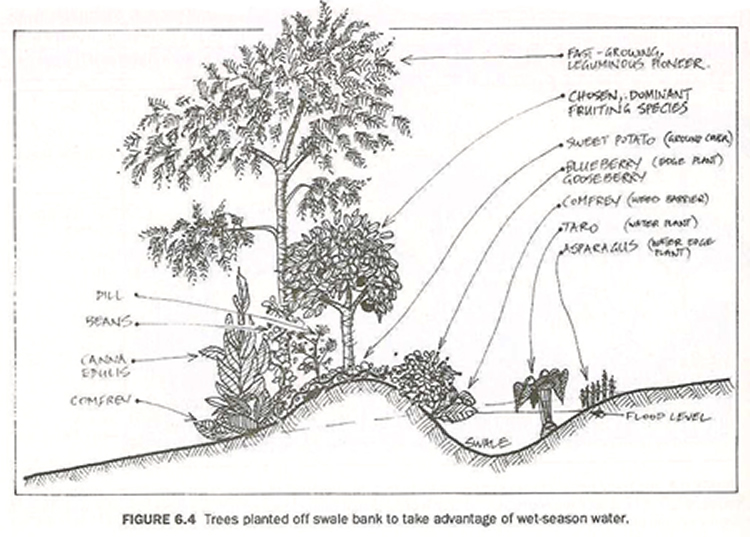

Water, to be useful and to become available to plants needs to soak into the ground. Problems always can occur when there is surface flow, which when it moves down hill will accelerate and cause gully erosion. As the gully becomes deeper the slope becomes steeper, accelerating the flow and allowing it to carry more soil away. This is a situation which will become steadily worse.


When the land is forested there is no soil erosion, instead you can expect soil accumulation. As we see in the illustration (from Permaculture designer’s manual, Mollison) a quarter of rainfall does not even reach the ground but is returned to the air as moisture evaporated from the leaves of the trees. Almost 50% of rainfall is transpired by trees leaving the remaining 25% to nourish soils and eventually find its way into the streams or ground water.

As soon as trees are removed soils will tend to dry out, become compacted and they lose much of their soil carbon which burns off as CO2. This makes the soil much less able to absorb rainfall and you start to have the problem of surface flow, which will open up gullies and soil will begin to migrate down hill.


- When this begins to happen it is essential to begin planning interventions to reverse this process as it will quickly become a much worse problem and fixing it will cost increasing amounts of resources and time.
- Essential things to do would be to begin actively observing and measuring to begin to understand the scale of the problem and to formulate responses.

On steeper slopes, especially those >18% trees may be used to stabalise soil, these can be given additional support by a series of interconnected ‘V’ shaped banks, used to intererupt surface flow, spreading it out and also directing it to the trees where it can be taken up and utilised. A thick mulch layer (dead, decaying organic matter) can really help absorb this water and hold it in place so that it can soak slowly into the soils.


In the above image looking at moderate slope with a flatter top, a series of swales (level water catchment features) traps water in a series of dams. This is not what we are proposing for the school, but there are interesting features to note.
- Any overflow from one dam is carefully managed and returned to the next, eliminating surface flow.
- Any places where there is a danger of the system overflowing is reinforced with dense tree plantings on contour.
- Discharge excess water into dense vegetation is a good rule.
- The chinampa feature is a strategy to slow water down by making it travel a long distance, the longer the distance it travels then the more it can be absorbed and better re-hydrate soils.
- At the base of the slope there is again dense plantings which also reinforces the system and reduces erosion in more extreme weather events.

This is a swale. It is essentially an excavated ditch, where the spoil is heaped up on the downside to create a bank. The intention is not for the water when trapped to flow sideways but for it to be held in place on a level, aligned to the contours of the slope.
- The bank should not be overly compacted as the intention is for water to soak into soils and slowly seep down into the lower soil horizons.



The process of establishing a swale involves surveying the land carefully and seeing where opportunities lie.
Only when the main components of the system have been considered should works begin. It is often a good approach to start in the middle of a landscape then add new rainwater catchment features above and below it.

The soils on the lower slope below the swale benefit from improved irrigation and this can be taken advantage of by planting a guild of plant species which in turn protect the soil with their foliage and bind the soils together with their roots.
- an essential lesson is to learn to keep soil covered as much as possible at all times. The best way to do this is with long term plants such as trees
- in the short term the soil can be protected with fast growing cover crops like peas and beans, pumpkins and the like as they will quickly cover the ground.
- In the immediate term soils can be protected with thick mulches of things like old dry grasses, compost, leaves and such like. These will break down and feed the first cover crop plants as they establish.



You must be logged in to post a comment.